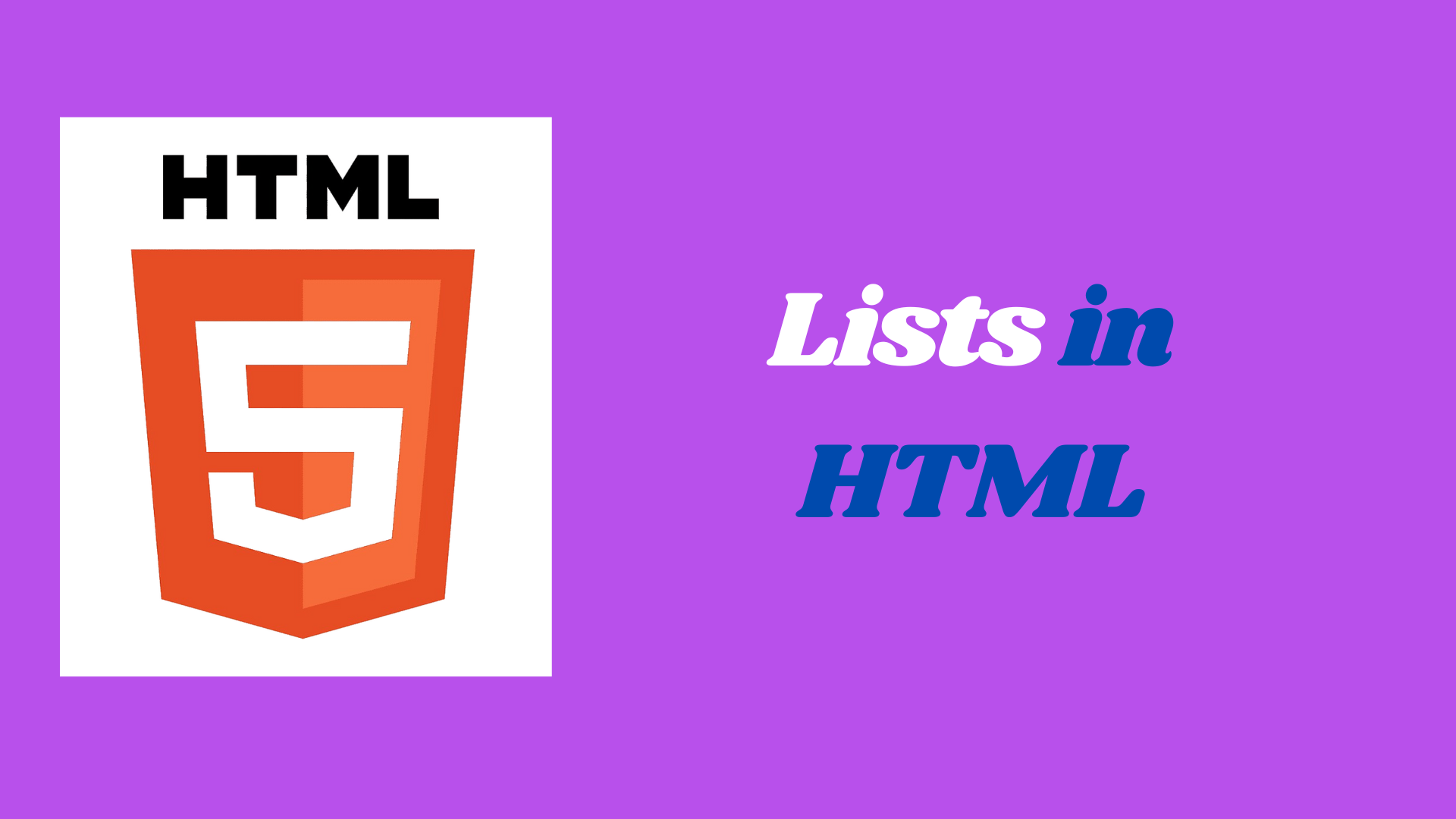Lists in Html
 Vivek Kumar
Vivek Kumar
Hello and Welcome dear developers! Today, I'll guide you through HTML lists, exploring their types, properties, attributes, and beyond. So without any delay let's just start.
Introduction
In the world of HTML, lists are the unsung heroes of content organization. They provide a structured and organized way to present information on web pages. HTML offers two main types of lists: ordered lists (<ol>) for sequentially numbered items and unordered lists (<ul>) for bullet-pointed items. Within these, the <li> (list item) tag houses individual list elements. Apart from it HTML also provides description list (<dl>). Let's discus about these one by one:
1. Ordered Lists(<ol>):
An ordered list in HTML is a way to organize and display information in a sequentially numbered format. It's created using the <ol> (ordered list) tag and consists of individual list items denoted by the <li> (list item) tag. The browser automatically numbers the list items sequentially. Here's a breakdown:
<ol>
<li>First item</li>
<li>Second item</li>
<li>Third item</li>
</ol>
Different Types of Ordered List:
The <ol> tag supports the type attribute, allowing you to customize the numbering style. The value of type attribute may include "1" (default, Arabic numerals), "A" (uppercase letters), "a" (lowercase letters), "I" (uppercase Roman numerals), and "i" (lowercase Roman numerals). Let's understand them one by one:
1. Default Ordered List (Numbers):
<ol>
<li>First item</li>
<li>Second item</li>
<li>Third item</li>
</ol>
Result:
First item
Second item
Third item
2. Uppercase Letters Ordered List:
<ol type="A">
<li>Apple</li>
<li>Banana</li>
<li>Cherry</li>
</ol>
Result:
A. Apple
B. Banana
C. Cherry
3. Lowercase Letters Ordered List:
<ol type="a">
<li>apple</li>
<li>banana</li>
<li>cherry</li>
</ol>
Result:
a. apple
b. banana
c. cherry
4. Uppercase Roman Numbers Ordered List:
<ol type="I">
<li>First item</li>
<li>Second item</li>
<li>Third item</li>
</ol>
Result:
I. First item
II. Second item
III. Third item
5. Lowercase Roman Numbers Ordered List:
htmlCopy code<ol type="i">
<li>First item</li>
<li>Second item</li>
<li>Third item</li>
</ol>
Result:
i. First item
ii. Second item
iii. Third item
2. Unordered Lists(<ul>):
An unordered list in HTML is a way to present information in a bullet-pointed format without any specific order or sequence. It's created using the <ul> (unordered list) tag and consists of individual list items denoted by the <li> (list item) tag. Here's an explanation:
<ul>
<li>First item</li>
<li>Second item</li>
<li>Third item</li>
</ul>
Different Types of Unordered List:
The <ul> tag in HTML provides flexibility in styling unordered lists. By utilizing the list-style-type property in CSS, you can customize the appearance of the list markers. The default style is typically disc-shaped bullets. However, you can choose from various styles, such as "square" for filled squares, "circle" for outlined circles, or even use a custom image as the marker. This adaptability allows web developers to match the design of unordered lists with the overall aesthetics of their websites. Let's understand different types of unordered lists with code examples:
1. Default Unordered List (Disks):
<ul>
<li>Apple</li>
<li>Orange</li>
<li>Banana</li>
</ul>
Result:
Apple
Orange
Banana
2. Square List:
<ul style="list-style-type: square;">
<li>Red</li>
<li>Green</li>
<li>Blue</li>
</ul>
Result:
■ Red
■ Green
■ Blue
3. Circle List:
<ul style="list-style-type: circle;">
<li>Sun</li>
<li>Moon</li>
<li>Stars</li>
</ul>
Result:
○ Sun
○ Moon
○ Stars
4. Custom Image List:
<ul style="list-style-image: url('custom-marker.png');">
<li>Item 1</li>
<li>Item 2</li>
<li>Item 3</li>
</ul>
Result:
Item 1
Item 2
Item 3
Note: For the custom image list, you need to replace 'custom-marker.png' with the path to your own image file.
You can also chose list-style type as none for no bullet-point.
3. Description List (<dl>):
A description list (<dl>) is used to represent a list of terms and their corresponding descriptions. It consists of term-definition pairs where each term is represented by the <dt> (definition term) tag, and each description is represented by the <dd> (definition description) tag. It is similar to a dictionary, where each term is followed by its definition. Here's an explanation with code examples:
<dl>
<dt>HTML</dt>
<dd>HyperText Markup Language</dd>
<dt>CSS</dt>
<dd>Cascading Style Sheets</dd>
<dt>JavaScript</dt>
<dd>A scripting language for web pages</dd>
</dl>
Result:
HTML
HyperText Markup Language
CSS
Cascading Style Sheets
JavaScript
A scripting language for web pages
In this example, each <dt> tag represents a term (e.g., HTML, CSS, JavaScript), and each <dd> tag represents the corresponding description.
Nesting of Lists:
Nesting of lists in HTML involves placing one list inside another list. This can be done with all 3 types of lists. Here's an example of nested lists:
1. Nested Unordered List:
<ul>
<li>Fruits</li>
<li>
Vegetables
<ul>
<li>Carrot</li>
<li>Broccoli</li>
<li>Spinach</li>
</ul>
</li>
<li>Grains</li>
</ul>
Result:
Fruits
Vegetables
Carrot
Broccoli
Spinach
Grains
In this example, the list of "Vegetables" is nested within the main list. The nested list is created using another <ul> element, and each vegetable is represented by an <li> element within that nested list.
2. Nested Ordered List:
<ol>
<li>Main Course</li>
<li>
Side Dishes
<ol>
<li>Mashed Potatoes</li>
<li>Steamed Vegetables</li>
<li>Coleslaw</li>
</ol>
</li>
<li>Desserts</li>
</ol>
Result:
Main Course
Side Dishes
Mashed Potatoes
Steamed Vegetables
Coleslaw
Desserts
3. Nested Description Lists:
<dl>
<dt>Frontend Technologies</dt>
<dd>
<dl>
<dt>HTML</dt>
<dd>HyperText Markup Language</dd>
<dt>CSS</dt>
<dd>Cascading Style Sheets</dd>
<dt>JavaScript</dt>
<dd>A scripting language for web pages</dd>
</dl>
</dd>
<dt>Backend Technologies</dt>
<dd>
<dl>
<dt>Node.js</dt>
<dd>JavaScript runtime for server-side development</dd>
<dt>Python</dt>
<dd>General-purpose programming language</dd>
<dt>PHP</dt>
<dd>Hypertext Preprocessor</dd>
</dl>
</dd>
</dl>
Result:
Frontend Technologies
HTML
HyperText Markup Language
CSS
Cascading Style Sheets
JavaScript
A scripting language for web pages
Backend Technologies
Node.js
JavaScript runtime for server-side development
Python
General-purpose programming language
PHP
Hypertext Preprocessor
👉If you want to explore more you can visit these:
1. Ordered List: https://developer.mozilla.org/en-US/docs/Web/HTML/Element/ol
2. Unordered List: https://developer.mozilla.org/en-US/docs/Web/HTML/Element/ul
3. Description List: https://developer.mozilla.org/en-US/docs/Web/HTML/Element/dl
Thank You
So that's all for today. Let's wrap up our discussion here. If you liked the Article consider sharing it with others and stay connected because much more is coming.
Your thoughts matter—feel free to drop any questions or suggest topics for discussion in the comments. Let's keep the conversation going!"
Subscribe to my newsletter
Read articles from Vivek Kumar directly inside your inbox. Subscribe to the newsletter, and don't miss out.
Written by
